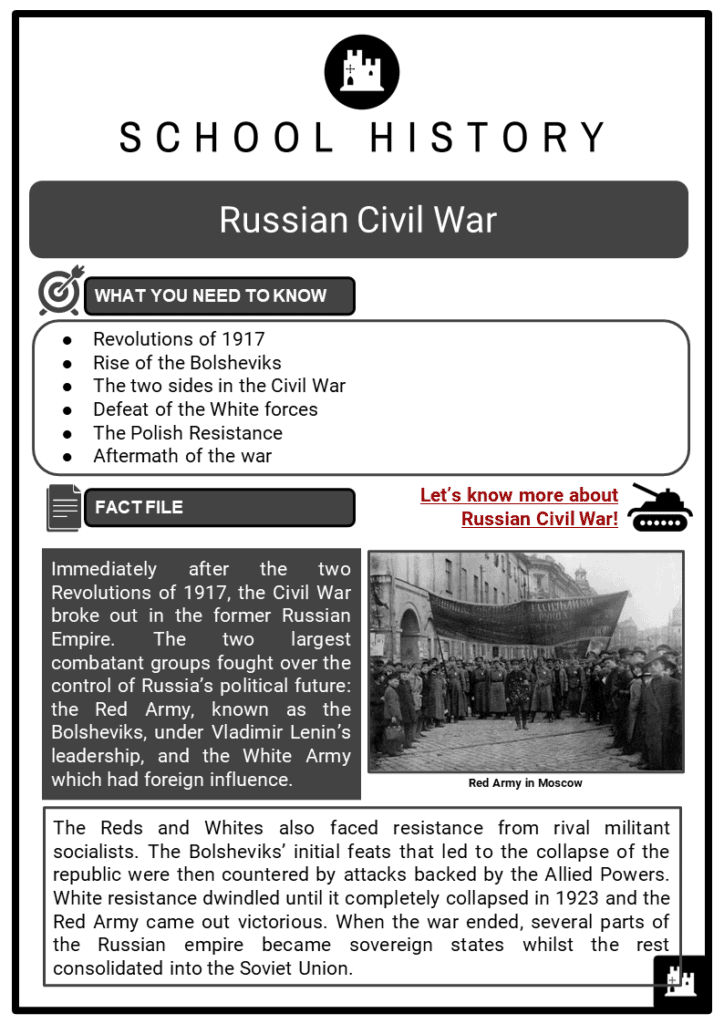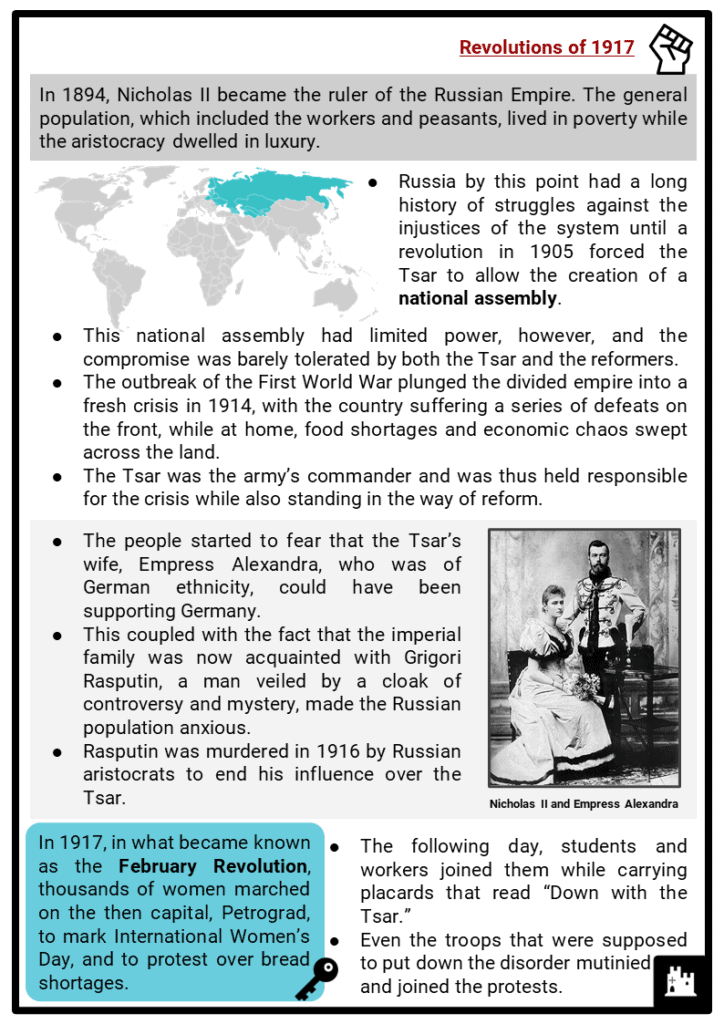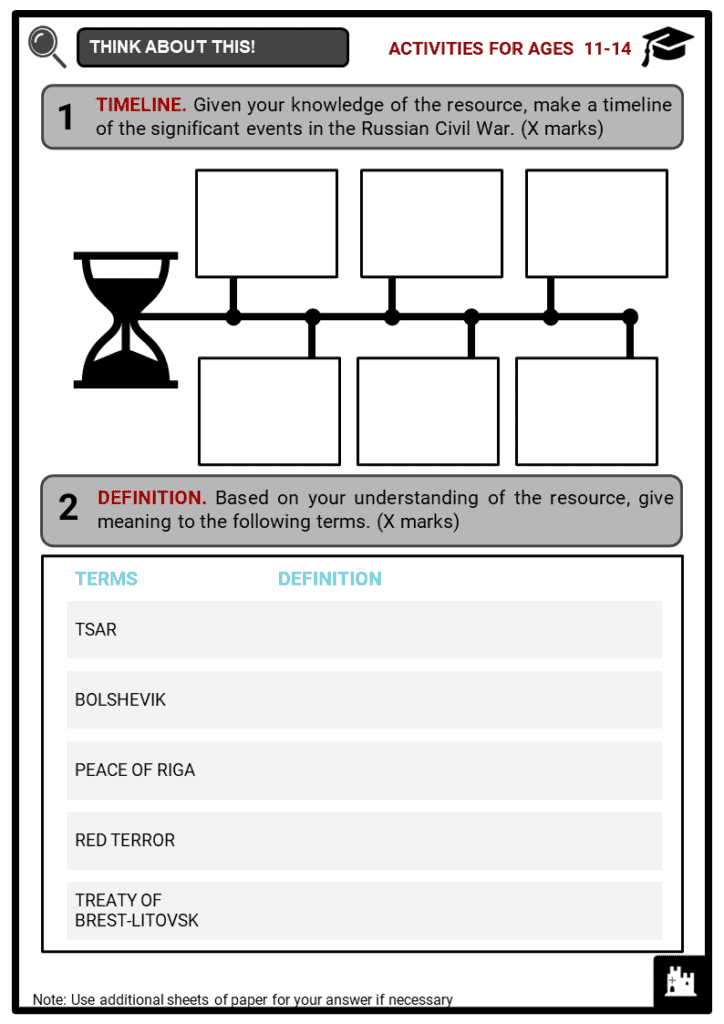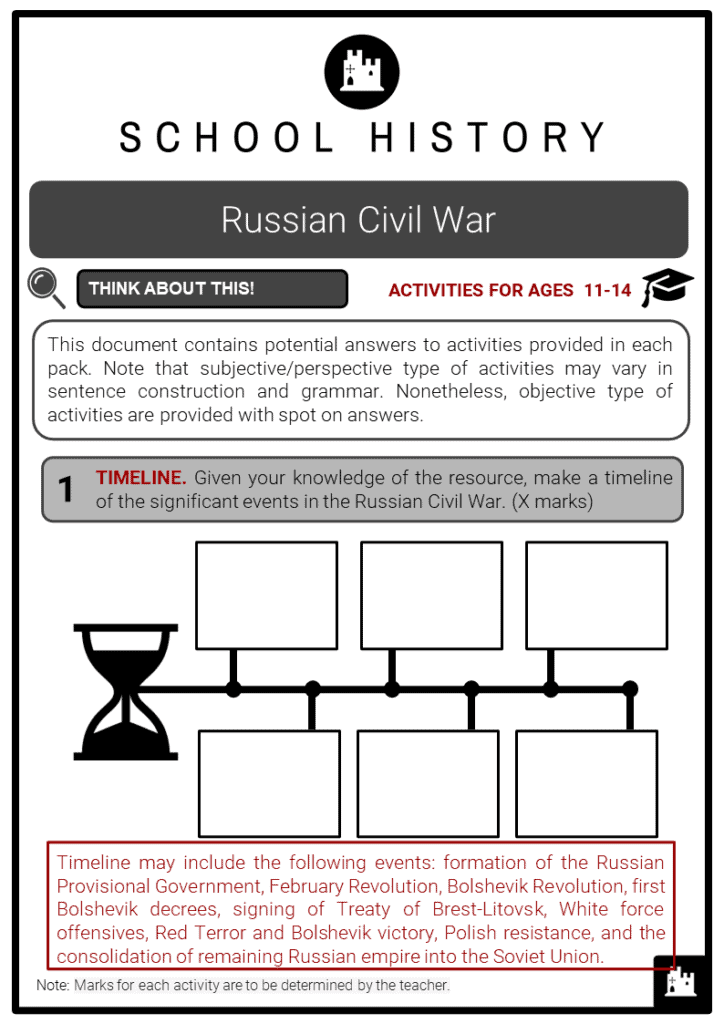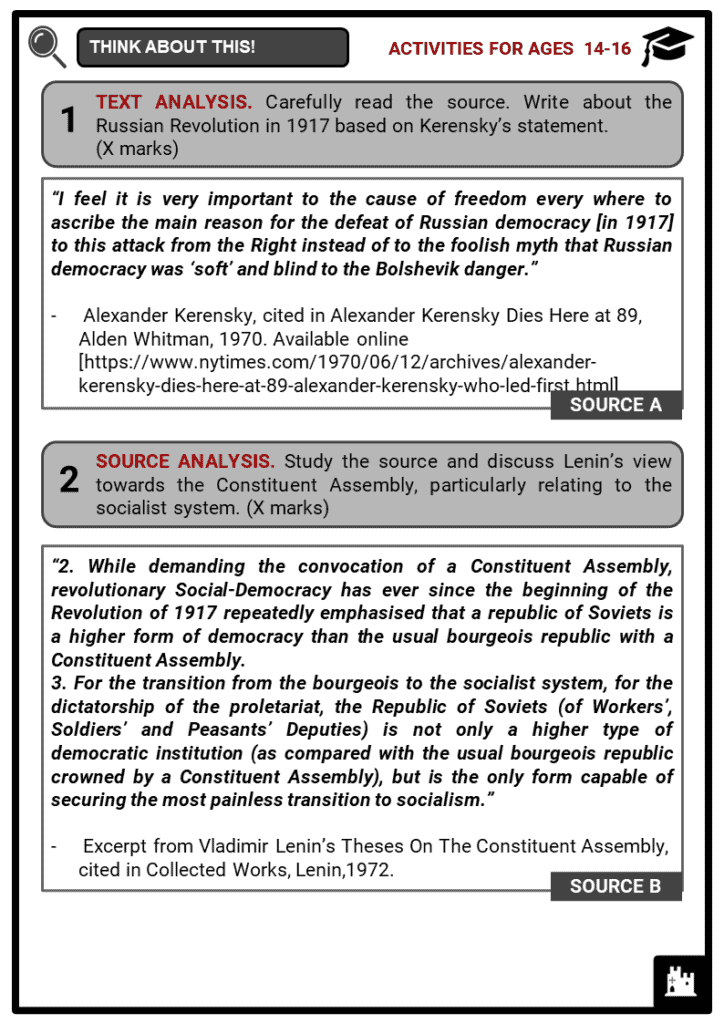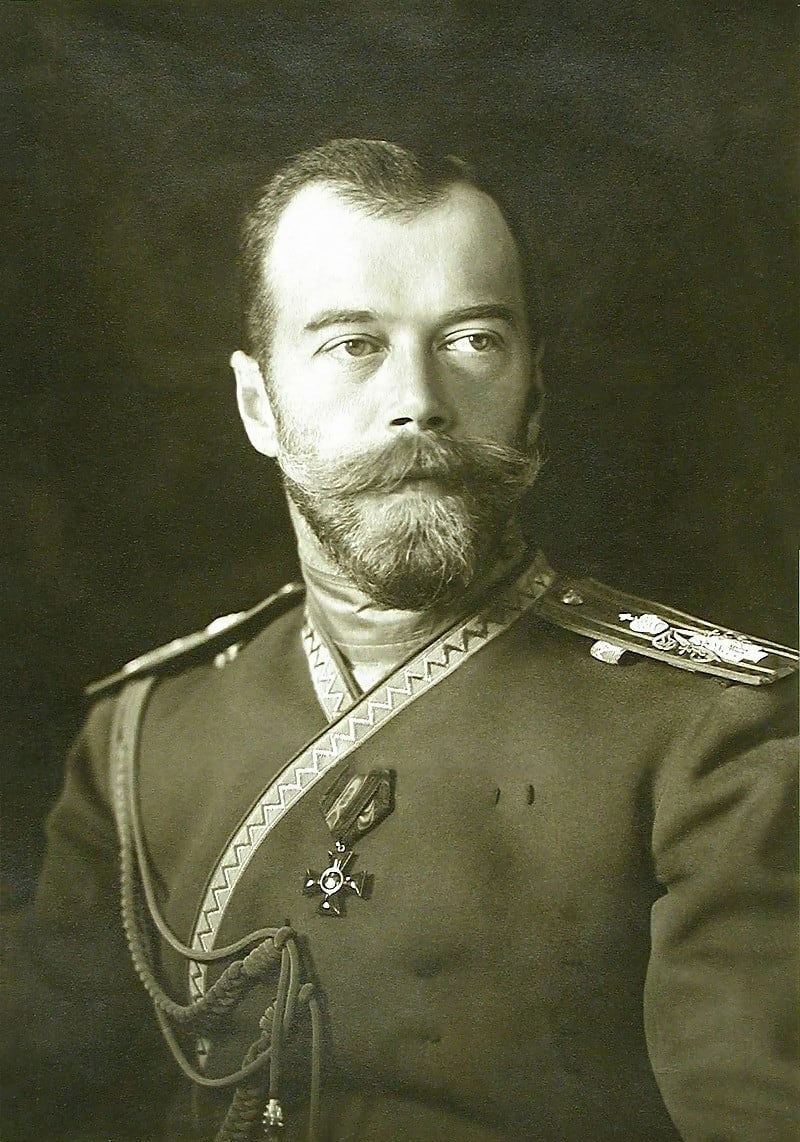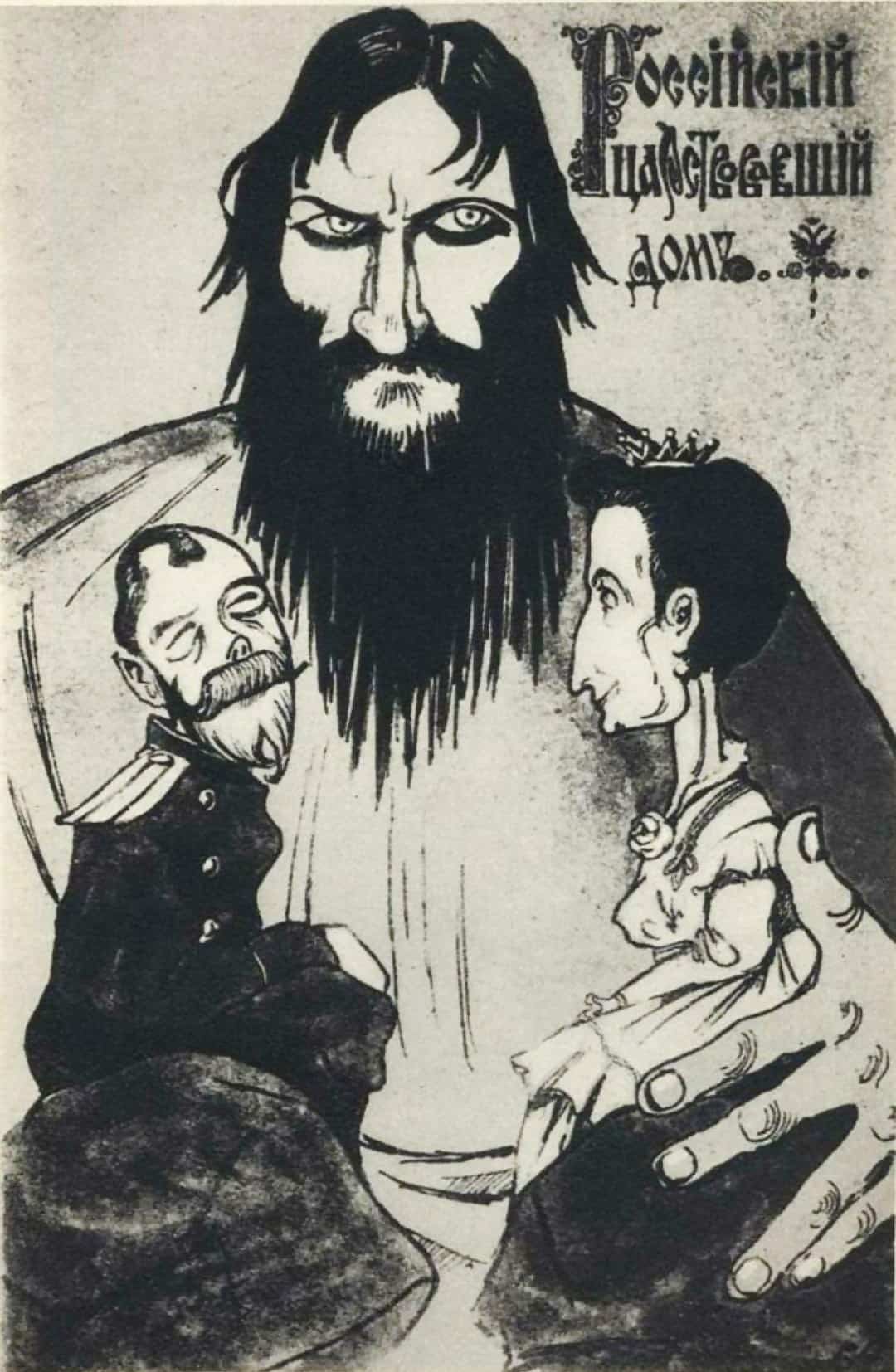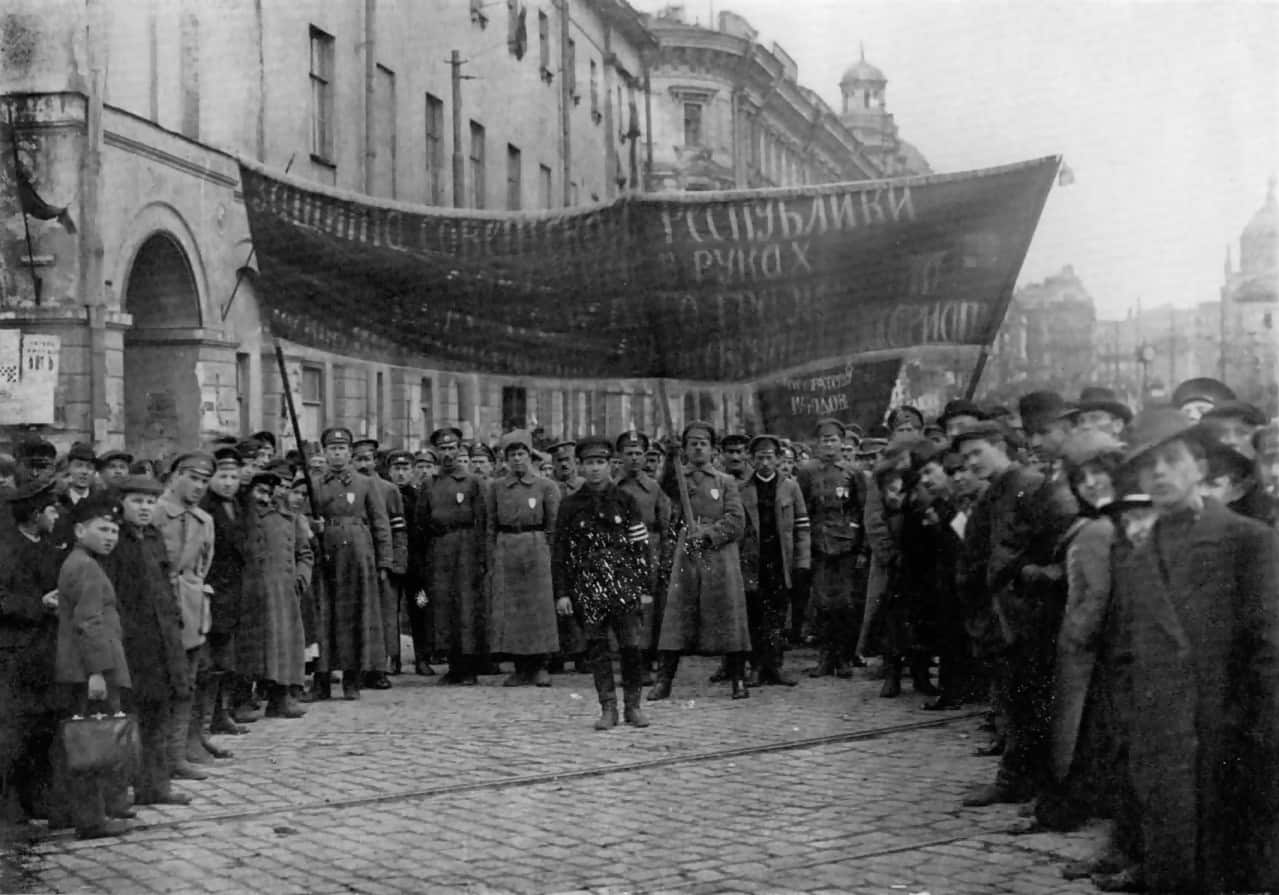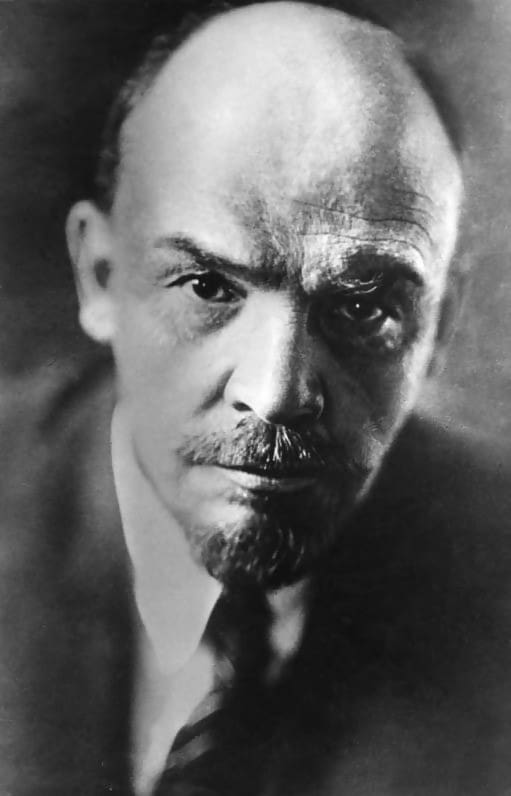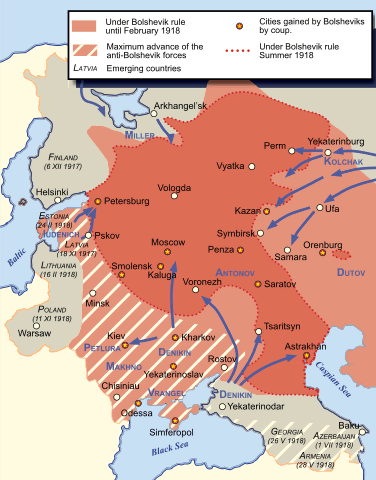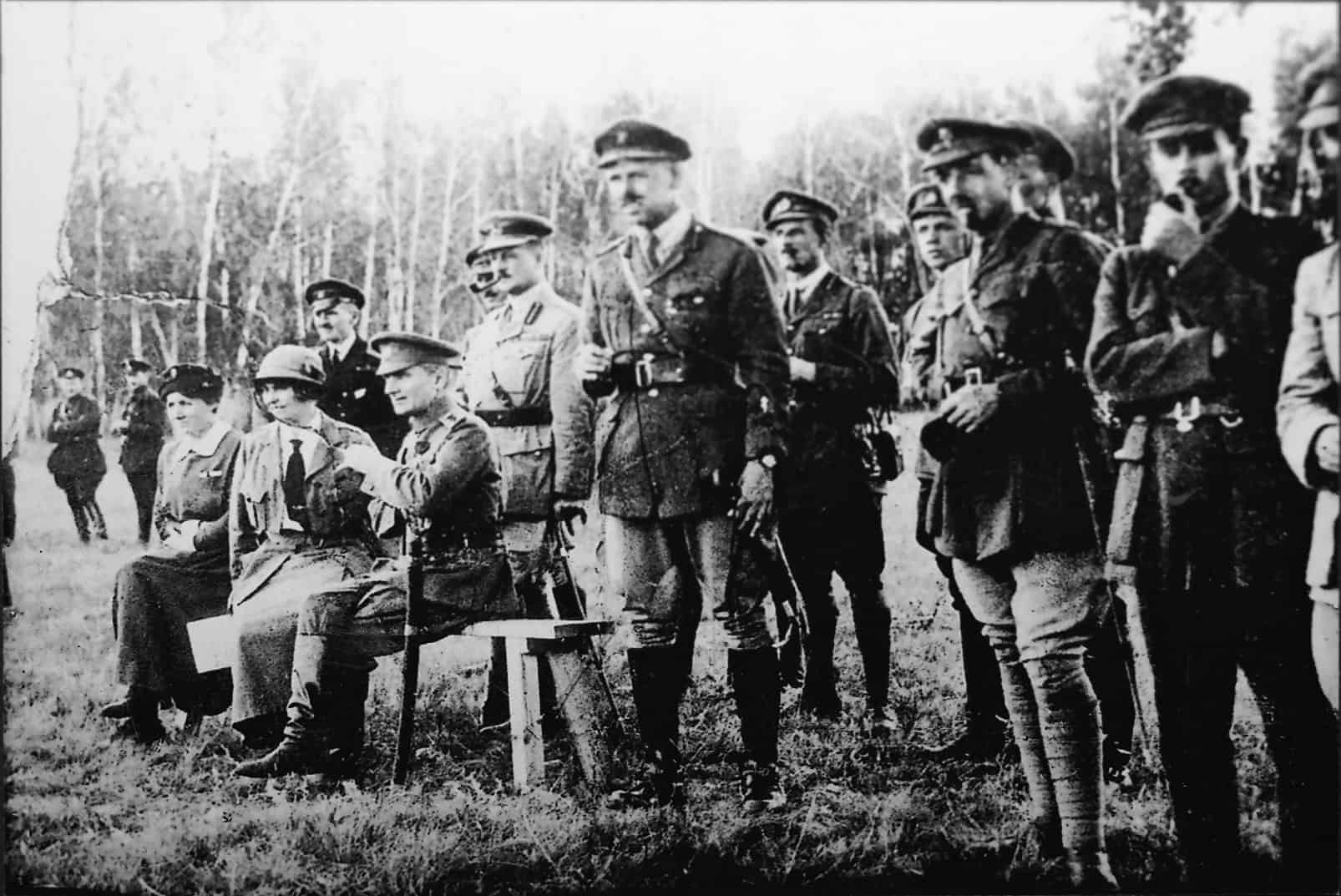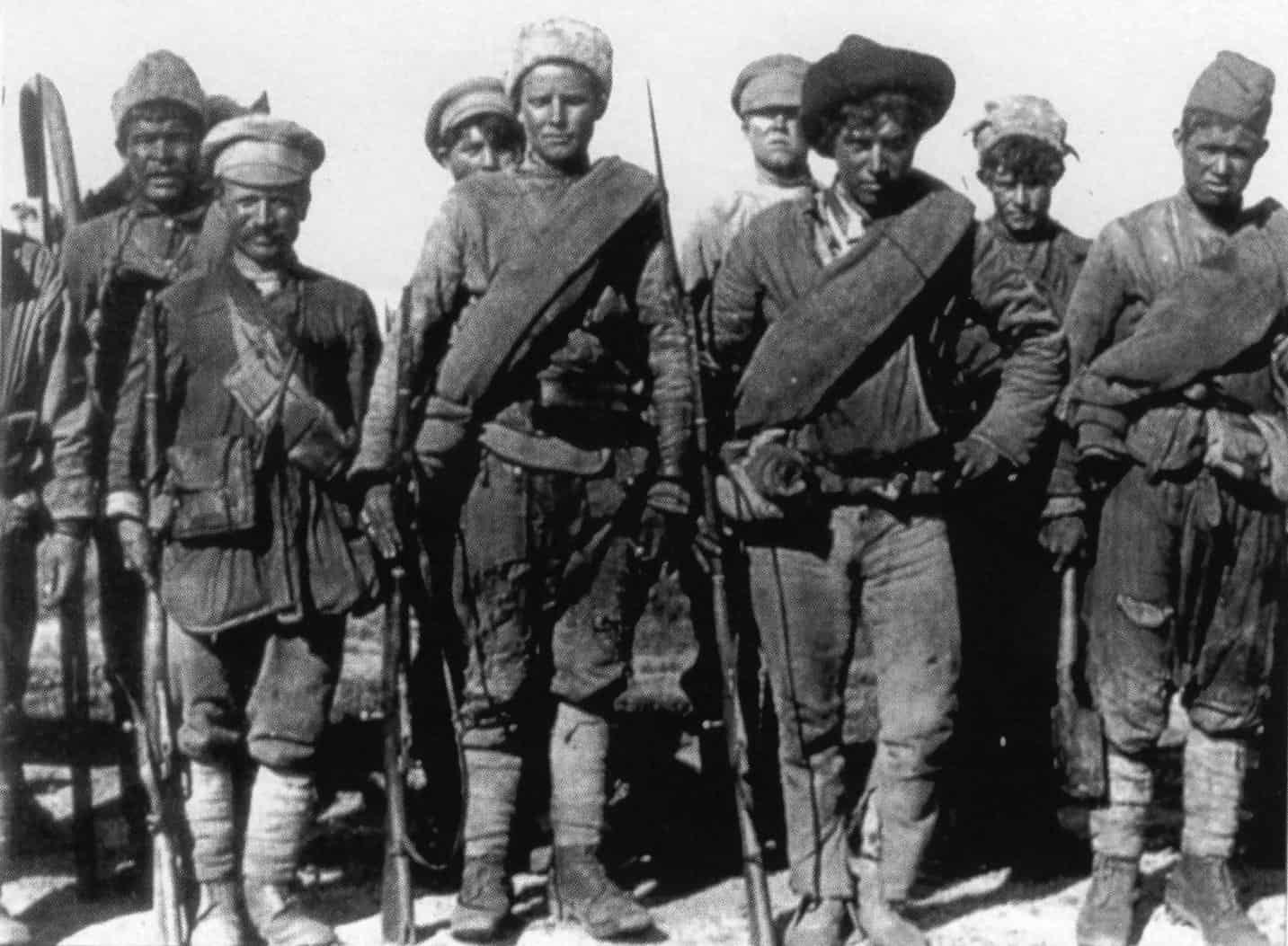Download Russian Civil War Worksheets
Do you want to save dozens of hours in time? Get your evenings and weekends back? Be able to teach Russian Civil War to your students?
Our worksheet bundle includes a fact file and printable worksheets and student activities. Perfect for both the classroom and homeschooling!
Summary
- Revolutions of 1917
- Rise of the Bolsheviks
- The two sides in the Civil War
- Defeat of the White forces
- The Polish Resistance
- Aftermath of the war
Key Facts And Information
Let’s know more about Russian Civil War!
- Immediately after the two Revolutions of 1917, the Civil War broke out in the former Russian Empire. The two largest combatant groups fought over the control of Russia’s political future: the Red Army, known as the Bolsheviks, under Vladimir Lenin’s leadership, and the White Army which had foreign influence.
- The Reds and Whites also faced resistance from rival militant socialists. The Bolsheviks’ initial feats that led to the collapse of the republic were then countered by attacks backed by the Allied Powers. White resistance dwindled until it completely collapsed in 1923 and the Red Army came out victorious. When the war ended, several parts of the Russian empire became sovereign states whilst the rest consolidated into the Soviet Union.
Revolutions of 1917
- In 1894, Nicholas II became the ruler of the Russian Empire. The general population, which included the workers and peasants, lived in poverty while the aristocracy dwelled in luxury.
- Russia by this point had a long history of struggles against the injustices of the system until a revolution in 1905 forced the Tsar to allow the creation of a national assembly.
- This national assembly had limited power, however, and the compromise was barely tolerated by both the Tsar and the reformers.
- The outbreak of the First World War plunged the divided empire into a fresh crisis in 1914, with the country suffering a series of defeats on the front, while at home, food shortages and economic chaos swept across the land.
- The Tsar was the army’s commander and was thus held responsible for the crisis while also standing in the way of reform.
- The people started to fear that the Tsar’s wife, Empress Alexandra, who was of German ethnicity, could have been supporting Germany.
- This coupled with the fact that the imperial family was now acquainted with Grigori Rasputin, a man veiled by a cloak of controversy and mystery, made the Russian population anxious.
- Rasputin was murdered in 1916 by Russian aristocrats to end his influence over the Tsar.
- In 1917, in what became known as the February Revolution, thousands of women marched on the then capital, Petrograd, to mark International Women’s Day, and to protest over bread shortages.
- The following day, students and workers joined them while carrying placards that read “Down with the Tsar.”
- Even the troops that were supposed to put down the disorder mutinied and joined the protests.
- This led to a wave of Tsarist officials being arrested, prisons and police station attacks and the emblems of Tsarist rule smashed and burned.
- The Tsar abdicated and as a result, a Russian Provisional Government was established thus leading to a situation of dual power and Russia becoming a republic in September.
- The government was now led by Socialist Revolutionary Party politician Alexander Kerensky.
- Once the Tsar abdicated, Vladimir Lenin came back from his exile and promoted the overthrow of the government.
- Kerensky was unable to solve the pressing issues of the country.
- Many people wanted an end to the war, but the government refused.
- In September 1917, a failed coup by General Lavr Kornilov led to a surge in support for the Bolshevik party.
- The Bolsheviks ended the dual power by suppressing the Provisional Government in late October, on the eve of the Second All-Russian Congress of Soviets. Kerensky was forced to flee. This would be known as the second revolution of 1917.
- Timeline overview of the Russian Civil War
- The Russian Civil War (1917–1923) occurred in three periods:
- October 1917 – November 1918: From the Bolshevik Revolution to the First World War Armistice
- January 1919 – November 1919: White Armies’ advances in the South, East and Northwest of Russia
- 1919-1923: Peripheral battles
Rise of the Bolsheviks
- The proclamation drafted by Lenin covered Bolshevik programmes and the formation of a new government. After the Bolshevik Revolution of 1917, the Bolsheviks spread out quickly throughout Russia. They used the volunteer-based Red Guards as their main military force.
- Lenin’s faction came to be known as Bolsheviks from the Russian bolshinstvo which means 'majority'.
- Lenin gained much support upon issuing decrees.
- FIRST BOLSHEVIK DECREES
- Decree on peace which stated armistice on all fronts
- Decree on land that distributed lands to peasant committees and abolished private land ownership
- Convocation of the Constituent Assembly
- Supply of bread to cities
- Workers’ Decree which reinforced workers’ control over production
Formation of a new government
- The Bolsheviks announced that there would be free and fair elections in November 1917, but they lost these elections.
- Lenin ordered his troops to shut down the Constituent Assembly in January 1918 and thus he gained more power.
- Leon Trotsky, the People’s Commissar for Military and Naval Affairs, reorganised the Red Guards into a Workers’ and Peasants’ Red Army in order to create a more effective fighting force.
- The chaos and disorder meant that there was little resistance to this so called “triumphant march of Soviet Power.”
- With the Imperial army disintegrating, and the aristocracy fleeing from the capital, the Tsarist officers were integrated into the new Red Army. Sometimes their families were taken as hostages to ensure loyalty.
- The majority of the Red Army divisional and corps commanders consisted now of ex-Tsarist officers.
The two sides in the Civil War
- The forces of the Central Powers advanced in the spring of 1918 into Russian territory. They occupied the western part of the empire. Whilst Trotsky and a team of delegates managed to secure a peace treaty with the German Empire and the Central Power, Russia faced humiliating territorial losses.
- It became known as the Treaty of Brest-Litovsk which happened in March 1918.
- The treaty was signed between the new Bolshevik government and the German Empire, Austro-Hungary, Bulgaria and the Ottoman Empire to end Russia’s participation in First World War.
- Russia ceded hegemony over the Baltic States to Germany, the province of Kars Oblast to the Ottoman Empire and recognised the independence of Ukraine.
- Moreover, the territories of Kars, Ardahan and Batum were handed to Turkey.
- As a result of the treaty, about 1 million square miles of former Russian territory and one-third of its population (roughly 55 million) were lost.
- More importantly, major industries of coal, oil and iron were taken.
- Trotsky and the Bolshevik delegation initially rejected the German terms but Lenin accepted them fearing that hostilities would resume.
- After the Bolshevik takeover of the Provisional Government, Lenin tried to safeguard his new society by accepting the Treaty of Brest-Litovsk, which he believed would end the consequences of war.
- By contrast, the United States, Britain, France and Tsarist loyalists in Russia were threatened thus the White Armies were formed.
Lenin and the Red Army
- Lenin ruled Russia by decree after he dismissed the Constituent Assembly.
- Upon the creation of the Red Army, Trotsky implemented a tough system and used propaganda to boost the morale of the conscripted peasants.
- The Bolshevik security agency, commonly known as Cheka, hunted down political enemies.
- The Bolsheviks implemented the War Communism, which provided supplies for the war effort.
- White Army and foreign powers
- Threatened by the Communist regime in Moscow, members of the Allied Powers supported Russian exiles to spread revolution.
- France and Italy supplied the White Army with munitions.
- Unlike the Reds, the White Armies had a number of leaders, including Yudenich, Denikin, Kolchak and Wrangel, who all wanted fame, glory and control over Russia.
- They divided their troops and attacked Russia on all sides.
- The Reds were fighting for a definite cause - the survival of Communism in Russia.
- The Whites fought independently from one another, and had various motives.
- Many Russians were in a sense contented because of new peace brought by the treaty but the Czechoslovakian legion saw this as a betrayal.
- They fought with Russia in the First World War for Czechoslovakia’s independence from the Austro-Hungarian Empire.
- With the recent actions of the Bolshevik government, they revolted in May 1918.
- The famous Czech Legion, made up of around 55,000 former Austro-Hungarian prisoners of war, mutinied and turned on the Bolsheviks.
- This resulted in the Bolsheviks’ power demise in most of Eastern Russia.
- The Allied Powers decided to intervene, sending armed forces comprised of British, French, American, Japanese, Serbian, Italian and Polish troops into the country, in the far north around the town of Arkhangelsk and in the east in Vladivostok in support of the Whites.
- The forces of the counter-revolution, led by former Tsarist generals, began to organise with the Allies’ help.
- A couple of battles took place in 1918, especially in the south and the east, and particularly along the railway lines.
- The intervention of the Allies was mostly to reopen the Eastern Front against Germany.
- The Allies supported the opponents of the Bolsheviks because they were worried about a possible Russo-German alliance and Communist revolutionary ideas spreading throughout their own lands.
- This intervention was victorious and led to the reduction of Bolsheviks to most of European Russia and parts of Central Asia.
Defeat of the White forces
- The Whites were successful initially against the Bolsheviks but their progress was soon stalled. They weren’t unified and many were fighting for their own independence and not to restore the Russian Empire.
- The White generals were usually incompetent.
- Alexander Kolchak struggled to keep his men sober, insulted his allies, and executed thousands of people that led to many more turning to the Bolshevik cause.
- Probably the greatest achievement of Alexander Kolchak was to capture Yekaterinburg, the city in which the former Russian emperor was held.
- This however also ended badly as it prompted the Bolsheviks to execute the royal family, for they feared that they would end up in the hands of the Whites.
- The execution took place on 17 July, 1918.
- In order to maintain control after an assassination attempt on Lenin left him seriously wounded by the Socialist Revolutionary Fanny Kaplan, the Bolsheviks began what is called The Red Terror in August 1918, a period of mass arrests and executions.
- Many dissidents were sent to work camps, protesters were shot and Trotsky held the families of generals hostage to ensure their loyalty.
- As the battles progressed, it soon became clear that the Bolsheviks were winning. The Allies withdrew their support and troops from Russia and the Czechoslovakian legion returned to their home which was by then independent. The Whites continued to lose battles and now without the help of foreign forces, their fate was sealed.
- Following the disastrous Novorossiysk evacuation in November 1920 which led to the split of Don and Volunteer armies of the Whites, Denikin stepped down and the military council elected Pyotr Wrangel as the new Commander-in-Chief of the White Army.
- He was able to restore order to the dispirited troops and reshape an army that could fight as a regular force again.
- However, Wrangel was soon defeated by the Red Army and the Black Army.
- After he retreated from Crimea, the Red Army turned against its former ally, the Black Army.
- The Red Army attacks on the anarchist forces and their sympathisers increased in ferocity throughout 1921.
- In Siberia, Admiral Kolchak’s army had disintegrated. He himself gave up command after the loss of Omsk.
- General Grigory Semyonov became the new leader of the White Army.
- Kolchak was arrested by the Czechoslovak Corps as he now travelled without the army’s protection. He was later killed.
- The remnants of his followers joined with that of Semyonov and with the help of the Japanese, they were able to hold the city of Chita.
- However, the Japanese pulled out their troops and Semyonov wasn’t able to hold against the advancing Red Army in November 1920.
- This marked the end of the White forces and the Bolsheviks asserted control over the Russian Far East.
The Polish Resistance
- The collapse of the Russian and Austro-Hungarian empires meant that many people in Eastern Europe were looking to establish their own nations and borders. The Polish led by Jozef Pilsudski wanted to expand the newly independent Poland at the cost of Russia, at the same time the Bolsheviks sought to spread Communism to their neighbours and reconquer territories.
- The Bolsheviks wanted to profit from the turmoil in Germany and the former Austro-Hungarian Empire by establishing Communist governments there.
- In 1919, the Polish invaded Ukraine and the Bolsheviks counter-attacked forcing them back to Warsaw, but the Polish stood their ground with their unexpected and decisive victory in the Battle of Warsaw.
- They maintained their independence and stopped the Bolsheviks from entering Germany. The war ended with the ceasefire in October 1920.
- The disputed territories were divided between Soviet Russia and Poland with the signing of Peace of Riga in March 1921.
- A series of borders were established, Ukraine and Belarus became socialist republics, in other words, Russian puppet states.
- For now, the spread of Communism in Eastern Europe was halted and the Bolsheviks turned their attention back home, to secure their position.
- Lesser battles continued on the periphery for two more years, and minor skirmishes with the remnants of the White forces in the Far East continued well into 1923.
Aftermath of the war
- The casualties of this war combined with famines were outstanding. There were between 7 and 12 million deaths, mostly civilians. Many pro-independence movements emerged after the break-up of the Russian Empire.
- Several parts of the former Russian Empire were established as sovereign states: Finland, Estonia, Latvia, Lithuania and Poland. They suffered their own civil wars and wars of independence.
- The rest of the former Russian Empire was consolidated into the Soviet Union. Russia and its puppet states agreed to form the Union of Soviet Socialist Republics (USSR).
- Lenin went on to fix Russia’s economy by implementing the New Economic Policy (NEP), a tactic to prevent further revolts. NEP enabled farmers to keep some of their surplus crops allowing for some of them to get wealthy.
- Lenin gradually became unwell until he died in 1924. Trotsky and Joseph Stalin were the only people who could replace him.
- Stalin at this point was a commander of the Red Army when it invaded Poland and by the time of Lenin’s death, he was the general secretary, the highest political post in the USSR.
- Trotsky, and to a certain extent Lenin, believed that a Communist Germany was necessary for the survival of the USSR while Stalin believed that Communism wasn’t strong enough in the USSR in order to be exported.
- Stalin in the end came out victorious in the struggle for power and exiled Trotsky in 1929. Trotsky was later assassinated in 1940.
- Stalin tightened his grip on the Soviet Union by using purges, assassinations and a secret police named the N.K.V.D.
Image source:
[1.] https://en.wikipedia.org/wiki/Nicholas_II_of_Russia#/media/File:%D0%98%D0%BC%D0%BF%D0%B5%D1%80%D0%B0%D1%82%D0%BE%D1%80_%D0%9D%D0%B8%D0%BA%D0%BE%D0%BB%D0%B0%D0%B9_II.jpg
[2.] https://upload.wikimedia.org/wikipedia/commons/d/dd/Rasputin_listovka.jpg
[3.] https://upload.wikimedia.org/wikipedia/commons/c/c6/Red_army_in_moscow.jpg
[4.] https://upload.wikimedia.org/wikipedia/commons/c/c6/Bundesarchiv_Bild_183-71043-0003%2C_Wladimir_Iljitsch_Lenin.jpg
[5.] https://en.wikipedia.org/wiki/File:Russian_civil_war_in_the_west.svg
[6.] https://upload.wikimedia.org/wikipedia/commons/7/70/Колчак%2C_Нокс_и_английские_офицеры_восточного_фронта.jpg
[7.] https://upload.wikimedia.org/wikipedia/commons/0/0e/Uniformes_%28koltchak%29_001.jpg

